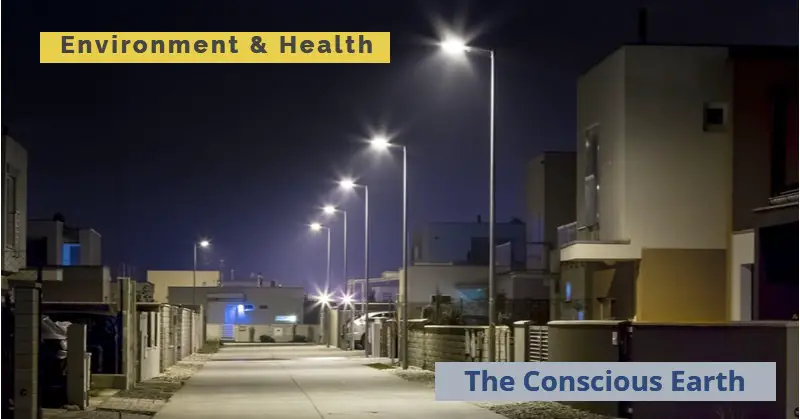Artificial outdoor light at night has been the subject of a range of research studies. Within the past few years, it has been “associated with depressive symptoms and suicidal behaviors” by a research team at the University of Seoul1; “significantly related to obesity” by a research team from Korea University College of Medicine2; and a team from Stanford and NASA’s Ames Research Center concluded that even though outdoor nighttime lights “improve the overall safety of people and traffic, nighttime lights in our streets and cities are clearly linked with modifications in human sleep behaviors and also impinge on the daytime functioning of individuals living in areas with greater outdoor nighttime lights.”3
Now, a study has been published by researchers at the National Institute of Mental Health, Columbia University, and Harvard’s School of Public Health that set out to explore whether levels of outdoor artificial light were associated with changes in adolescents’ sleep patterns and/or mood and anxiety disorders. 4
The team used satellite images mapped to U.S. Census blocks to gauge levels of nighttime artificial light and compared it with data gathered from a study of adolescents in the U.S. conducted over a three-year period called the National Comorbidity Survey-Adolescent Supplement. The mean age of the 10,123 adolescents in the study group was 15.2. The study adjusted for sociodemographic characteristics, population density, and socioeconomic status.
The primary outcomes and measures used for the study included, “Self-reported habitual sleep patterns (weeknight bedtime, weeknight sleep duration, weekend bedtime delay, and weekend oversleep) and past-year mood, anxiety, behavior, and substance use disorders, measured via an in-person structured diagnostic interview. Parent-reported information was included in behavior disorder diagnoses.”4
The study found higher levels of outdoor artificial light were associated with later weeknight bedtimes. Adolescents in the group rated lowest for exposure to nighttime light reported the longest weeknight sleep durations (adolescents in group rated highest for exposure to artificial outdoor light at night went to bed 29 minutes later and slept 11 fewer minutes than those in the lowest rated group).
The study found that higher levels of outdoor artificial light were associated with a higher prevalence of mood and anxiety disorder in the past year, including bipolar disorder, phobias, and major depressive disorder. 4
The authors suggest that future studies should examine whether steps to reduce exposure to nighttime outdoor artificial light might improve both mental and sleep health.
A press release about the study from the National Institute of Mental Health quoted senior investigator in the study, Kathleen Merikangas, PhD, saying, “Although environmental light exposure is only one factor in a more complex network of influences on sleep and behavior, it is likely to be an important target for prevention and interventions in adolescent health.”5
While preliminary studies such as this are initial building blocks in the body of knowledge about whether artificial light truly does negatively affect sleep patterns and mental health, it certainly seems that any measures to assure adolescents have window coverings that do a good job of blocking out outdoor artificial light at night would be a good step at this point in our understanding.
—R.A. Kroft
Sources:
1Min JY, Min KB. Outdoor light at night and the prevalence of depressive symptoms and suicidal behaviors: A cross-sectional study in a nationally representative sample of Korean adults. Journal of Affective Disorders. 2018;227:199-205. doi:10.1016/j.jad.2017.10.039
2Koo YS, Song JY, Joo EY, et al. Outdoor artificial light at night, obesity, and sleep health: Cross-sectional analysis in the KoGES study. Chronobiology International. 2016;33(3):301-314.
3Ohayon MM, Milesi C. Artificial Outdoor Nighttime Lights Associate with Altered Sleep Behavior in the American General Population. Sleep. 2016;39(6):1311-1320.
4Paksarian D, Rudolph KE, Stapp EK, et al. Association of Outdoor Artificial Light at Night With Mental Disorders and Sleep Patterns Among US Adolescents. JAMA Psychiatry. Published online July 08, 2020. doi:10.1001/jamapsychiatry.2020.1935
5NIMH. Outdoor Light Linked with Teens’ Sleep and Mental Health. National Institute of Mental Health. Press Release. 8 July 2020.
—
R.A. Kroft writes about her day-to-day journey in living a smaller, more sustainable life and other topics that interest her.

This Site Was Inspired By An Interest in Protecting the Environment:
We had the privilege and joy of learning from Dr. Charlie Stine who instilled a love for the natural world through incredible field trips with the Johns Hopkins Odyssey Certificate program in Environmental Studies. At the time, the program was endorsed by the Maryland Department of Natural Resources. Sadly, after Dr. Stine retired, the program was phased out. We hope that we honor his legacy by shining a bright light on environmental issues and sharing good news about the success of various conservation programs when possible.

